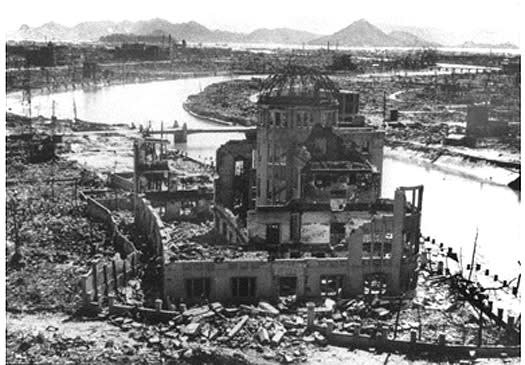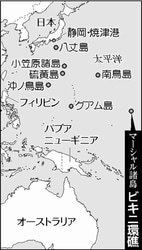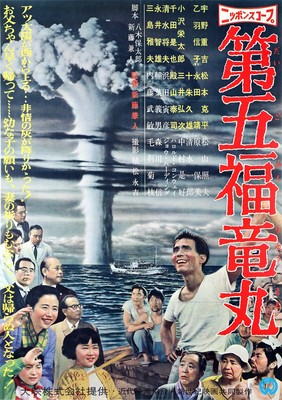A Tokyo Subway Station
Miracles before the Hiroshima Day
It was a very hot day, today.
I was walking to a railroad station, wishing that God would show me a miracle. I looked up at the sky, and there were no clouds at all, even no drifting ones. "This is the very blue sky of August," I thought. On a raised path between buildings, I checked Mt. Fuji, 100 km far. The air with summer vapor hindered the view of the mountain. Only a lower slope of Mt. Fuji was seen.
When I was returning from the station, I found that one big clump of clouds occupied a part of the west sky. It was dark in the evening sky. Then without sounds, the whole clump of clouds flashed. The instant strong light from the inside of the clouds showed detailed structure of the clump, though it was fairly far. It was not yet a huge cumulonimbus cloud, but it had a similar momentum in a way of overlapping various gray clouds to form the one big clump in the western sky.
A flash of lightening repeated in an interval of about 5 seconds. I stopped walking to observe them many times untiringly. It is as if huge bombs had been exploding endlessly in the dark clouds without sounds. However only a few pedestrians realized the mysterious show in the sky around Tokyo.
Later I checked a newspaper and found some articles about Japan-related WWII stories, including the 1941 Hiroshima atomic bomb:
Some Americans were promoting a project to return Japanese flags US soldiers had collected in battle fields in the Pacific Ocean in WWII to families of fallen Japanese soldiers who had possessed the flags when they died. Some members of the project visited the Prime Minister Office to hand over scores of old Japanese flags to PM Shinzo Abe.
Another article introduced two women who suffered the Hiroshima atomic bomb attack in August 1941: one died in 2011 and another still alive. They are just ordinary Japanese women but they wrote books about their experiences in Hiroshima.
Ms. Teiko Okuda was 31 years old at the time. She was not directly exposed to the blast of the atomic bomb, but she ventured into Hiroshima City to look for a child of her brother who had been sent overseas as a soldier. Ms. Okuda walked through the devastated city for eight days from the day when Hiroshima was attacked. She was carrying some foods and water, which she gave to suffering children whenever she encountered them on the destroyed streets of Hiroshima. Every child dying in her arms wished to give foods and water they were being provided for by Ms. Okuda to their dying family members. Ms. Okuda later wrote a book on this tragic experiences to publish it at her own expense. The circulation of copies of the book was thus limited. But last year a producer of a major publisher found this book to decide its release from the company, though Ms. Okuda died at the age of 96 in 2011, while her self-published book reached the fourth edition.
Ms. Shizue Inada, 95 years old, issued a book last year on her Hiroshima experiences. She was working as a 24-year old public heath nurse in a town 6 km far from the center of Hiroshima City. In a house where she visited for her duty in the morning of August 6, 1941, she witnessed a huge mushroom cloud of the atomic bomb. She returned to the town office while watching the weird cloud. Then she started to help and treat victims of the atomic bomb attack in a first-aid station set up in a primary school. Six days after the tragic day, she went to the center of explosion to look for acquaintances. After that, her whole body exhibited purple blotches; she though she was dying, too. But she survived to date. Next year she married and moved to a prefecture near Tokyo to work and raise three children. She joined some anti-nuclear movement managed by exposed persons. She even traveled to the US and Switzerland for peace activities. And, though she is very old now, she decided to issue a book last year.
Indeed, it is August 5 today, and it will be August 6 tomorrow: the Hiroshima Day.
Finally as part of a miracle of today, I am writing this report.
A uranium gun-type atomic bomb (Little Boy) was dropped on Hiroshima on August 6, 1945, followed by a plutonium implosion-type bomb (Fat Man) on the city of Nagasaki on August 9. Little Boy exploded 2,000 feet above Hiroshima in a blast equal to 12-15,000 tons of TNT, destroying five square miles of the city. Within the first two to four months of the bombings, the acute effects of the atomic bombings killed 90,000–166,000 people in Hiroshima and 39,000–80,000 in Nagasaki; roughly half of the deaths in each city occurred on the first day.
https://en.wikipedia.org/wiki/Atomic_bombings_of_Hiroshima_and_Nagasaki#Hiroshima
(According to Hiroshima City, at the time 350,000 soldiers and citizens, including Taiwanese and Koreans and American prisoners of war, were living or passing the city. It is not yet known precisely how many people were killed in Hiroshima, though it is thought that 140,000 people died due to the atomic bomb attack by the end of December 1941.
The number of fallen Japanese soldiers in Hiroshima is believed to be between 10,000 and 30,000. In addition, the number of American prisoners of war killed in Hiroshima was 23, though only 17 of them were identified with their names.)

Near the Center of Explosion, Hiroshima City, before the Atomic Bomb Attack
http://blog.goo.ne.jp/nak2006/e/3c3f5c246a86582fa7f016bd1360200a

After the Blast of the Atomic Bomb
http://blog.goo.ne.jp/raymiyatake/e/eda6395faa79938f08f52d9194104ccb
**** **** ****
Act 8:5 Then Philip went down to the city of Samaria, and preached Christ unto them.


























